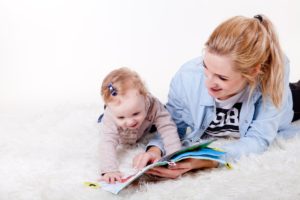Creating a Language Rich Environment

How do children learn language? This is truly a complex answer, but we can easily rule out some ways they do *not* learn language. Generally speaking, infants and toddlers don’t learn words by looking at flashcards or by hearing the word in isolation. Children learn words and their meanings by hearing them over multiple exposures, in a natural context, and within their environment. “Look at that dog! Oh, he’s such a cute doggy. Do you want to pet the dog?” Each time a child sees a new or different dog and hears the vocabulary, they are able to build from what they already know to enrich their understanding of vocabulary and language.
When children enter preschool and early elementary school, there is still a wealth of vocabulary for them to learn and absorb. Furthermore, we are exposed to new vocabulary throughout our lives, even into adulthood; think of some of the complex word we may learn in chemistry, calculus, or economics. As educators, we have the opportunity to support this vocabulary development by making some small, deliberate adjustments to how we present language to our students. These strategies may be applied on broad level for younger children, but they can still be used at a more targeted level for older students and complicated subjects.

Here are three ideas for educators to support a language rich environment:
- One of the most simple and powerful ways to expose children to new words and rich language is through book reading. Research has found that hearing one book a day can expose a child to nearly 300,000 words from birth to age 5. Books provide new vocabulary within the context of a story, where pictures (for young children) and words a child already knows can help them “figure out” the meaning of new words. Educators can support this by encouraging children to identify words they don’t know and even pre-teaching words that may be new and unfamiliar. We can also show older children how to use context clues themselves.
- A strategy that is particularly applicable to preschool and elementary classrooms involves considering the quality of input we as educators provide. For example, it is common to see preschool classrooms with labels on items throughout the room: “window, door, light switch, sink” which is a fantastic first step towards supporting language. However, labels that are purely nouns or names lack context. Nouns can only go so far in communicating a message. This is where the next step of deliberateness comes in. We can modify labels to expand beyond nouns and include other functional vocabulary such as actions, colors, or other descriptive words. For example, labels for door can expand to “front door, open door, close door” and table can expand to “small table, red table, on table”.
- A third way for educators to support a rich language environment is in their responsiveness to students during their conversations. When we, as adults, pause and wait, it allows students to lead the conversation, take turns, and process what is being said. We can also imitate and rephrase utterances to indirectly correct grammatical errors; for example, when a student says “I winned!”, the teacher can respond “Yes, you won!” Additionally, teachers can use scripting, or parallel talk, to narrate situations and scenarios using thematic vocabulary. For example, during a play scene, a teacher or service provider can talk about vocabulary including “shopping cart, cash register” and other topic-specific objects and actions.
Learning language may be a complex process, but we don’t need to overcomplicate the matter. Slight modifications to the conversations and interactions we are already having with our students can provide a more enriching, supporting, learning environment for all students.








